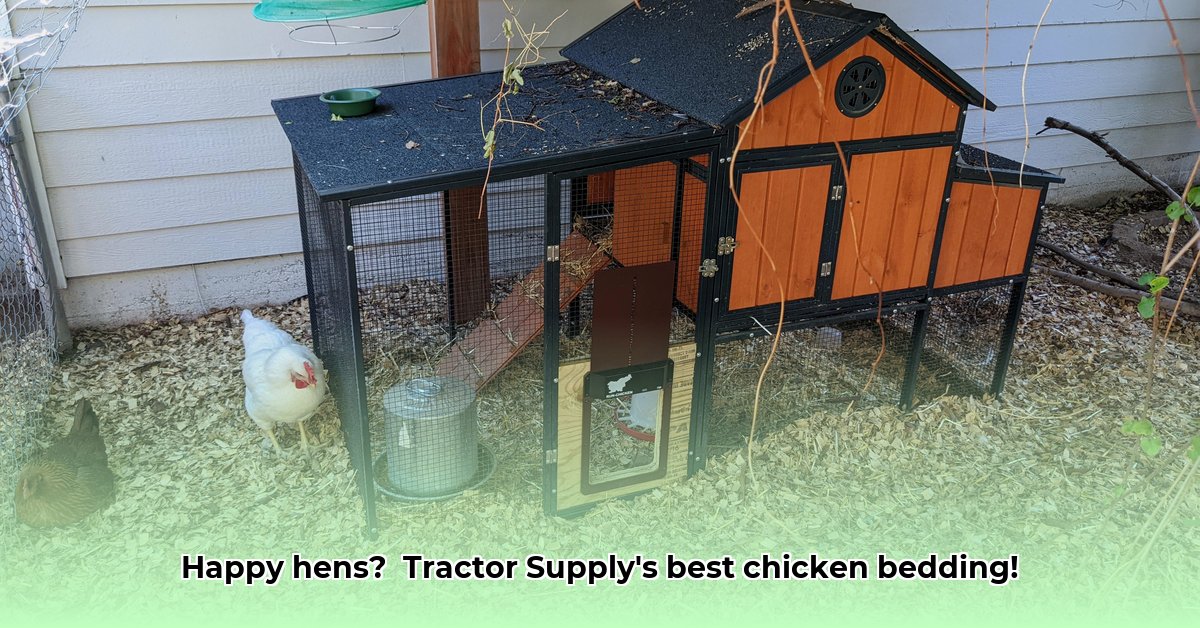
Finding the right bedding for your chickens is crucial for their health and comfort. This guide helps you navigate the options available at Tractor Supply, whether you're a seasoned poultry farmer or a backyard hobbyist. We'll compare different types of bedding, detail proper setup, and offer tips for maintaining a clean and healthy coop—all while promoting sustainable practices. For more information on chicken coops at Tractor Supply, check out this helpful resource.
Choosing the Perfect Bedding for Your Flock
Before selecting bedding, consider your chickens' specific needs. The number of birds, coop ventilation, and your priorities (ease of cleaning, cost, eco-friendliness) all influence the best choice. A well-ventilated coop might tolerate less absorbent bedding than a poorly ventilated one, for example. What are your top priorities?
Your Chicken Bedding Options at Tractor Supply: A Detailed Comparison
Tractor Supply offers various bedding materials, each with pros and cons. Let's examine popular options:
1. Pine Shavings: The Classic, but Not Always Ideal
Pine shavings are a common choice due to their affordability and readily available nature. They offer moderate absorbency. However, the dust can irritate chickens' respiratory systems, and the oils can sometimes irritate their skin. Avoid pine shavings for very young chicks.
2. Wood Pellets: High Absorbency, Higher Cost
Wood pellets offer superior absorbency, resulting in a drier, cleaner coop. The low dust content is beneficial. However, they are typically pricier than shavings and require significant moisture to break down, potentially impacting composting efficiency. Are the benefits of reduced labor and cleaner environment worth the increased cost?
3. Hemp Bedding: Eco-Friendly and High-Performing
Hemp bedding is rapidly gaining popularity due to its exceptional absorbency, odor control, and natural antimicrobial properties. It creates a healthier environment, potentially reducing the need for veterinary care. From a sustainability standpoint, hemp is an environmentally friendly choice. The higher initial cost might be offset by reduced labor costs and longer lifespan.
4. Straw: Budget-Friendly but Less Effective
Straw offers a budget-friendly option, but its low absorbency requires more frequent cleaning. Furthermore, chickens can easily ingest it, potentially causing digestive problems, especially for younger birds. Is saving money worth the additional labor and potential health risks?
Hemp Bedding: A Deeper Dive into Sustainability
Hemp's superior absorbency translates to less frequent cleaning, saving you time and effort. Its antimicrobial properties minimize odors and promote a healthier environment for your flock. While the initial cost is higher, these long-term benefits may offset the added expense.
Bedding Comparison: A Quick Reference Guide
This table summarizes the key characteristics of each bedding type:
| Feature | Pine Shavings | Wood Pellets | Hemp Bedding | Straw |
|---|---|---|---|---|
| Absorbency | Moderate | High | High | Low |
| Dust | High | Low | Low | Moderate |
| Cost | Low | Moderate | Moderate-High | Low |
| Odor Control | Moderate | Moderate | High | Low |
| Environmental Impact | Moderate | Moderate | High | Moderate |
| Ease of Cleaning | Moderate | Moderate | High | Low |
Making the Right Choice: A Personalized Approach
The best bedding depends on your individual needs and preferences. Carefully weigh the pros and cons of each option, considering cost, time constraints, and flock health. Remember, regular coop checks are vital; dampness or strong odors signal a need for bedding replacement.
How to Compare Hemp and Traditional Bedding Cost-Effectively
Choosing the right bedding involves examining initial cost, longevity, and disposal methods. Hemp bedding, while pricier upfront, potentially offers long-term savings through reduced labor and waste. Traditional options remain affordable but require more frequent changes, increasing labor costs.
Considering Scale: Backyard vs. Large-Scale Operations
Small-scale operations might prioritize affordability and ease of use, while larger operations focus on cost per bird and labor efficiency. This difference influences your cost-benefit analysis.
Calculating True Cost: Beyond the Initial Purchase Price
A comprehensive cost comparison includes:
- Initial purchase price: Cost per unit.
- Bedding lifespan: How long does it last before needing replacement?
- Labor costs: Time spent cleaning and replacing bedding.
- Disposal/composting: Costs associated with waste removal or composting.
By carefully considering these factors, you can make an informed decision about which bedding option is most cost-effective for your operation.
Pros and Cons: A Balanced Perspective
| Feature | Hemp Bedding | Traditional Bedding (e.g., Straw, Pine Shavings) |
|---|---|---|
| Absorbency | Excellent; reduces ammonia & odors | Moderate; Requires more frequent changes |
| Odor Control | Excellent; naturally antimicrobial | Moderate; May require additional odor control measures |
| Compostability | Excellent; enriches soil | Good; depends on material and composting technique |
| Initial Cost | Higher | Lower |
| Labor Costs | Lower (due to less frequent changes) | Higher (due to more frequent changes) |
| Availability | May be less readily available in some areas | Widely available |
Ultimately, the optimal choice depends on your specific situation. A thorough cost-benefit analysis is crucial for making the most economical and sustainable decision for your chicken coop.